
Ānanda was the primary attendant of the Buddha and one of his ten principal disciples. Among the Buddha's many disciples, Ānanda stood out for having the best memory. Most of the texts of the early Buddhist Sutta-Piṭaka are attributed to his recollection of the Buddha's teachings during the First Buddhist Council. For that reason, he is known as the Treasurer of the Dhamma, with Dhamma referring to the Buddha's teaching. In Early Buddhist Texts, Ānanda was the first cousin of the Buddha. Although the early texts do not agree on many parts of Ānanda's early life, they do agree that Ānanda was ordained as a monk and that Puṇṇa Mantānīputta became his teacher. Twenty years in the Buddha's ministry, Ānanda became the attendant of the Buddha, when the Buddha selected him for this task. Ānanda performed his duties with great devotion and care, and acted as an intermediary between the Buddha and the laypeople, as well as the saṅgha. He accompanied the Buddha for the rest of his life, acting not only as an assistant, but also a secretary and a mouthpiece.

Wilhelm Richard Wagner was a German composer, theatre director, polemicist, and conductor who is chiefly known for his operas. Unlike most opera composers, Wagner wrote both the libretto and the music for each of his stage works. Initially establishing his reputation as a composer of works in the romantic vein of Carl Maria von Weber and Giacomo Meyerbeer, Wagner revolutionised opera through his concept of the Gesamtkunstwerk, by which he sought to synthesise the poetic, visual, musical and dramatic arts, with music subsidiary to drama. He described this vision in a series of essays published between 1849 and 1852. Wagner realised these ideas most fully in the first half of the four-opera cycle Der Ring des Nibelungen.

Der fliegende Holländer, WWV 63, is a German-language opera, with libretto and music by Richard Wagner. The central theme is redemption through love. Wagner conducted the premiere at the Königliches Hoftheater Dresden in 1843.

Lohengrin, WWV 75, is a Romantic opera in three acts composed and written by Richard Wagner, first performed in 1850. The story of the eponymous character is taken from medieval German romance, notably the Parzival of Wolfram von Eschenbach, and its sequel Lohengrin, itself inspired by the epic of Garin le Loherain. It is part of the Knight of the Swan legend.
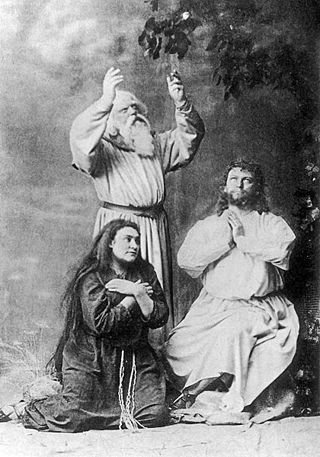
Parsifal is a music drama in three acts by the German composer Richard Wagner and his last composition. Wagner's own libretto for the work is freely based on the 13th-century Middle High German chivalric romance Parzival of the Minnesänger Wolfram von Eschenbach and the Old French chivalric romance Perceval ou le Conte du Graal by the 12th-century trouvère Chrétien de Troyes, recounting different accounts of the story of the Arthurian knight Parzival (Percival) and his spiritual quest for the Holy Grail.

Tristan und Isolde, WWV 90, is an opera in three acts by Richard Wagner to a German libretto by the composer, based largely on the 12th-century romance Tristan and Iseult by Gottfried von Strassburg. It was composed between 1857 and 1859 and premiered at the Königliches Hoftheater und Nationaltheater in Munich on 10 June 1865 with Hans von Bülow conducting. Wagner referred to the work not as an opera, but called it "eine Handlung".
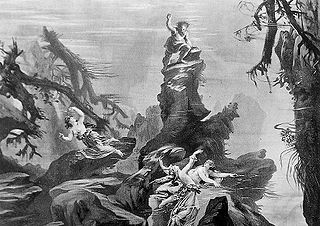
Das Rheingold, WWV 86A, is the first of the four music dramas that constitute Richard Wagner's Der Ring des Nibelungen. It was performed, as a single opera, at the National Theatre Munich on 22 September 1869, and received its first performance as part of the Ring cycle at the Bayreuth Festspielhaus, on 13 August 1876.
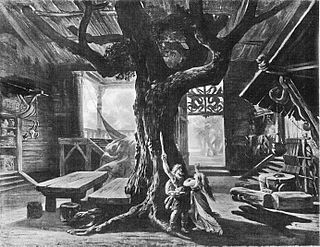
Die Walküre, WWV 86B, is the second of the four music dramas that constitute Richard Wagner's Der Ring des Nibelungen. It was performed, as a single opera, at the National Theatre Munich on 26 June 1870, and received its first performance as part of the Ring cycle at the Bayreuth Festspielhaus on 14 August 1876.
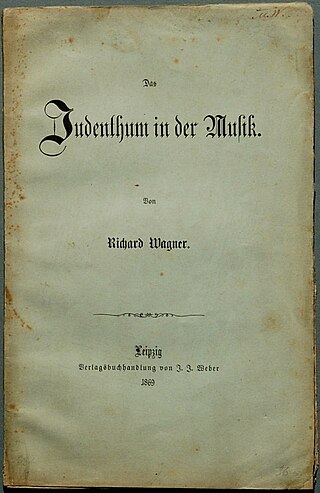
"Das Judenthum in der Musik" is an essay by Richard Wagner which attacks Jews in general and the composers Giacomo Meyerbeer and Felix Mendelssohn in particular. It was published under a pseudonym in the Neue Zeitschrift für Musik (NZM) of Leipzig in September 1850 and was reissued in a greatly expanded version under Wagner's name in 1869. It is regarded by some as an important landmark in the history of German antisemitism.

Tannhäuser is an 1845 opera in three acts, with music and text by Richard Wagner. It is based on two German legends: Tannhäuser, the mythologized medieval German Minnesänger and poet, and the tale of the Wartburg Song Contest. The story centres on the struggle between sacred and profane love, as well as redemption through love, a theme running through most of Wagner's work.
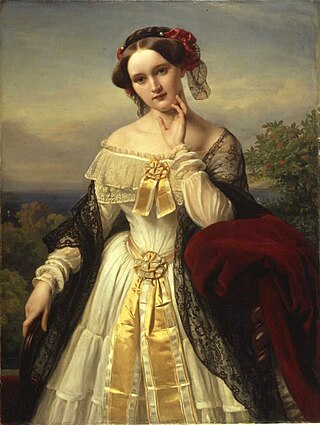
Wesendonck Lieder, WWV 91, is the common name of a set of five songs for female voice and piano by Richard Wagner, Fünf Gedichte für eine Frauenstimme. He set five poems by Mathilde Wesendonck while he was working on his opera Tristan und Isolde. The songs, together with the Siegfried Idyll, are the two non-operatic works by Wagner most regularly performed.

The evolution of Richard Wagner's epic operatic tetralogy Der Ring des Nibelungen was a long and tortuous process, and the precise sequence of events which led the composer to embark upon such a vast undertaking is still unclear. The composition of the text took place between 1848 and 1853, when all four libretti were privately printed; but the closing scene of the final opera, Götterdämmerung, was revised a number of times between 1856 and 1872. The names of the last two Ring operas, Siegfried and Götterdämmerung, were probably not definitively settled until 1856.
The composition of the epic operatic tetralogy The Ring of the Nibelung occupied Richard Wagner for more than a quarter of a century. Conceived around 1848, the work was not finished until 1874, less than two years before the entire cycle was given its premiere at Bayreuth. Most of this time was devoted to the composition of the music, the text having been largely completed in about four years.

The German composer Richard Wagner was a controversial figure during his lifetime, and has continued to be so after his death. Even today he is associated in the minds of many with Nazism and his operas are often thought to extol the virtues of German nationalism. The writer and Wagner scholar Bryan Magee has written:
I sometimes think there are two Wagners in our culture, almost unrecognizably different from one another: the Wagner possessed by those who know his work, and the Wagner imagined by those who know him only by name and reputation.

"The Artwork of the Future" is a long essay written by Richard Wagner, first published in 1849 in Leipzig, in which he sets out some of his ideals on the topics of art in general and music drama in particular.
Wieland der Schmied is a draft by Richard Wagner for an opera libretto based on the Germanic legend of Wayland Smith. It is listed in the Wagner-Werk-Verzeichnis as WWV82.
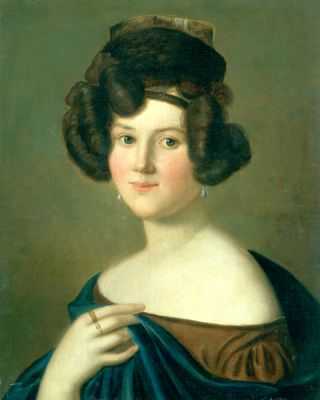
Christine Wilhelmine "Minna" Planer was a German actress and the first wife of composer Richard Wagner, to whom she was married for 30 years, although for the last 10 years they often lived apart. At an early age, she had an illegitimate daughter with a Royal Saxon Army officer, whom she raised as her sister. After a stormy courtship, which involved infidelities on both sides, she married Richard Wagner in 1836.
Wagner Dream is an opera by Jonathan Harvey, premiered in 2007, to a libretto by Jean-Claude Carrière, which intertwines events on the last day of the life of Richard Wagner with elements from a fragmentary opera sketch by Wagner himself, Die Sieger.

Wieland der Schmied(Wieland the Smith; Slovak: Kováč Wieland) is an opera in three acts by Ján Levoslav Bella first performed in 1926, to a libretto by Oskar Schlemm based on an original libretto draft by Richard Wagner.














